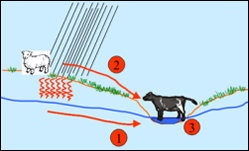Cow crossings and water quality
Research Status: Ongoing |
Cow crossing experiment in Sherry River |
Introduction
Pastoral agriculture has been implicated as the single largest cause of water pollution in New Zealand. Characteristic concentrations of the favoured faecal indicator organism (Escherichia coli) in agricultural streams are typically around 20 times higher than those in forested catchments, and frequently exceed guidelines for contact recreation. Direct access of livestock to stream channels is thought to be a major cause of diffuse faecal pollution, possibly of comparable overall importance to wash-in of faecal matter from contributing areas of pasture after rainstorms.
Research Approach
A joint TDC/NIWA/Cawthron/LandCare team studied the water quality effects of a dairy cow raceway crossing on the Sherry River in the Motueka Catchment in October, 2001.
A preliminary experiment on 11 October served to indicate that the plume of dirty water mobilised by the cows could be used to guide sampling for the faecal indicator bacterium E coli, and other water quality variables indicative of faecal pollution and sediment disturbance.
This experiment guided the design of a definitive experiment on 11 October in which the crossing was recorded by two video cameras, and the water quality effects were documented by continuous monitoring of turbidity and beam transmittance, and by close-interval sampling for analysis of faecal indicator bacteria and other variables.
Research Results
The crossing of the whole herd as a bunch on the way to the afternoon milking produced a major “spike” of turbidity, with visual clarity dropping temporarily from 2 m to as low as 100 mm. Very high faecal bacterial concentrations were measured in the turbid plume (exceeding 50,000 cfu/100 mL of E. coli) - which may be compared to a contact recreation guideline (median) of 126 cfu/100 mL. The peak E. coli concentrations are broadly comparable with those measured by Adrian Meredith (Env. Canterbury) on a cow crossing event in Canterbury.
After milking, the cows re-crossed the river as individuals or small groups, and turbidity and E. coli were variable and much less elevated, albeit for a longer period of time. Total mobilisation of both light-attenuation and faecal bacteria were similar on both crossings to and from the milking shed. Comparison of cow voiding "events" in the 17 m wide stream with fresh cow pats counted along the raceway suggests that the cows were more than 50 times as likely to void in the stream than in equivalent distances elsewhere on their path to and from the milking shed. This work has directly documented appreciable water pollution associated with cattle access to streams.
Bridging the Sherry River at cow crossings has been subsequently undertaken at 4 localities. Water quality monitoring is on-going to determine any improvements as a result of the bridging and riparian management.
 |
 |
Fecal pathways (Rob Davies-Colley) |
Cows defacating in the Sherry River |
Recent Publications
Recent Presentations
BMPs, BEPs and Guidelines
| Title | Description |
| Using Riparian Strips to Reduce Microbe Pollution | Rob Collins reports on operational research contracted by MAF to better understand the attenuation o...More » |
| Microbiological Water Quality Guidelines for Marine and Freshwater Recreational Areas |
From guide: The Microbiological Water Quality Guidelines for Marine and Freshwater Recreationa...More » |
| Clean Streams: A Guide to Managing Waterways on Tasman – Marlborough Farms |
From booklet: This booklet provides information about how to manage waterways to improve water...More » |
| Culvert and Bridge Construction Guidelines for Farmers |
From guide: These guidelines provide dairy farmers considering constructing a culvert or bridg...More » |
| Dairying and the Environment: Managing Farm Dairy Effluent |
From manual: The purpose of this manual is to assist dairy farmers and farm management special...More » |
| A Guide to Managing Farm Dairy Effluent – Tasman/Marlborough |
From booklet: This booklet provides best management practices for the main systems currently o...More » |
| Code of Practice for Nutrient Management | Fert Research’s Code of Practice for Nutrient Management (2007) considers fertiliser use withi...More » |
| Farm Dairy Effluent: Best practice guidelines |
From website: To help dairy farmers manage farm dairy effluent, the Farm Dairy Effluent bookle...More » |
| Dairy Shed Effluent Treatment and Disposal Guidelines |
From Booklet: This guideline is to provide some assistance to the farming community about what...More » |
| Clean Streams: A Guide to Managing Waterways on Southland Farms | A Guide to Managing Waterways on Southland Farms; intended to provide the best possible dairy farm m...More » |
Primary Contacts:
.jpg)
|
Rob Davies-Colley
Email Phone: (07) 856-1725 Fax: (07) 856-0151 More details» |
Institute National Institute of Water and Atmospheric Research (NIWA) |
Expertise water quality (esp. optics of water, faecal indicator bacteria), stream habitat, riparian ecology |